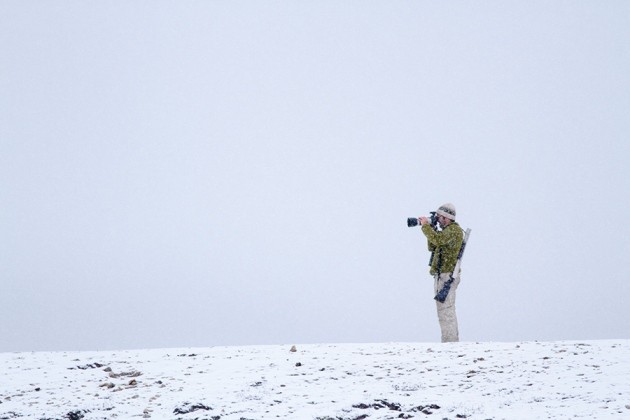
- Select a language for the TTS:
- UK English Female
- UK English Male
- US English Female
- US English Male
- Australian Female
- Australian Male
- Language selected: (auto detect) - EN
Play all audios:
The Museum of Jewish Art and History in Paris is one of the great Jewish museums in Europe. Located near the Marais, the famous Jewish district in Paris, it opened in 1998, and exhibits
works from the Middle Ages to the 20 th century. The range of objects is extraordinary: paintings by such important modern Jewish artists as Marc Chagall and Max Liebermann, sabbath dishes,
torah scrolls and menorahs, copies of gravestones from eastern Europe, wedding dresses from North Africa and images of Dreyfus. A new exhibition about the history of _ The Dybbuk _ has just
opened. It tells the story of one of the most celebrated Jewish works of the 20 th century. _ The Dybbuk _ was written by S. An-Sky, born Shloyme-Zanvl Rappoport (1863-1920). Between
1912-1914 he headed several Jewish ethnographic expeditions to Volhynia and Podolia in Ukraine, where they found hundreds of traditional Jewish stories, songs, Hasidic melodies and collected
around a thousand photographs. In 1914 An-Sky wrote _The Dybbuk_: first in Russian, then he translated it into Yiddish. The play tells the story of the possession of a young woman by the
malicious spirit – known as a _dybbuk_ in Jewish folklore – of her dead beloved. _The Dybbuk_ had its world premiere in Yiddish, performed by the Vilna Troupe in Warsaw in 1920. On 1
September 1921, the play had its American premiere in New York. A Hebrew version was prepared by Bialik and staged in Moscow at the famous Habima Theater in 1922. It was later filmed in
Yiddish in 1937, directed by Michał Waszyński, and the exhibition in Paris includes some extraordinary clips from the film, images of a bygone world destroyed by the Holocaust just a few
years later. The exhibition tells the story of these first productions, putting them in their historical context, with powerful contemporary paintings of traditional Jewish life in Russia
and the early Soviet Union by Chagall, Mané-Katz, Ryback and Nathan Altman. These artists were all Jews, born in Ukraine or Belarus in the late 19 th century, a Jewish world which still
existed when An-Sky set off to document Jewish culture in the Russian Pale. It then goes on to show Altman’s studies of costumes for _ The Dybbuk _ and photos, posters and programmes of
early productions from Vilna, Riga, Moscow, Warsaw and Paris, between the early 1920s and 1930s. A later section shows images from some of the best known post-war films and theatre
productions, including Wajda’s production in Krakow in 1988, the first performance in Polish since the war. The timing of this great production was no coincidence. It marked the 20 th
anniversary of the Jewish exodus of March 1968—the final blow to Jewish life in post-Holocaust Poland—and was intended to honour the upcoming 45 th anniversary of the Warsaw Ghetto Uprising.
It was a landmark in the history of postwar Poland’s coming to terms with what had happened to its Jewish population during the Holocaust. Warlikowski’s later production opened in 2003 on
Yom Kippur. He told one interviewer, “If Poles don’t adopt a new way of thinking about Jews, we will never be at peace with ourselves. Anything we say will be dishonest. Theatre will be
dishonest.” The exhibition goes on to show sequences from _ A Serious Man _ (2009), a film by the Coen Brothers. A Jewish man in a 19th-century Eastern European shtetl tells his wife
that he was helped on his way home by Reb Groshkover, whom he has invited in for soup. She says Groshkover is dead and the man he invited must be a dybbuk . _ _ The exhibition,
accompanied by a superbly illustrated catalogue (only available in French), tells a fascinating story, starting with popular tales of spirits and possession, then moving onto An-Sky’s famous
ethnographic expedition. It goes on to show how _ The Dybbuk _ occupies a unique place between Jewish tradition and the 20 th century avant-garde, both in film and theatre. It ends with
rich accounts of late 20 th century productions in Poland and Hollywood, showing how this strange story has attracted famous theatre directors and filmmakers from Wajda to Sidney Lumet and
the Coen Brothers. The exhibition, _ Le Dibbouk: Fantome du monde disparu, _ lives up to its name. It brings to life the lost world of pre-revolutionary Russian Jewish _ stetls _ and a
vanished world of spirits and storytelling. It reminds us that An-Sky’s play was originally called _ The Dybbuk, or Between Two Worlds _ . This is the story of two very different worlds: the
lost world of spirits and the modern world of post-war Poland and Hollywood, the two separated forever by the Holocaust. _ The Dybbuk: Phantom of the Lost World _ is at The Museum of The
Art and History of Judaism, 71, rue du Temple, Paris, 28 September 2024-26 January 2025. A MESSAGE FROM THEARTICLE _We are the only publication that’s committed to covering every angle. We
have an important contribution to make, one that’s needed now more than ever, and we need your help to continue publishing throughout these hard economic times. So please, make a donation._






